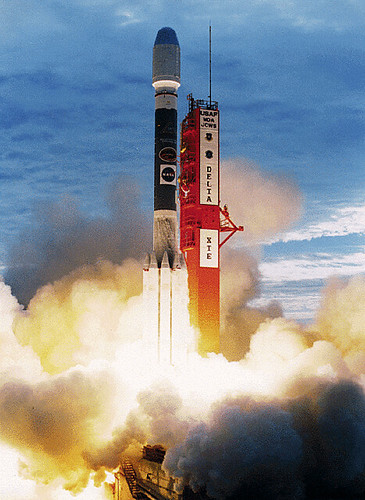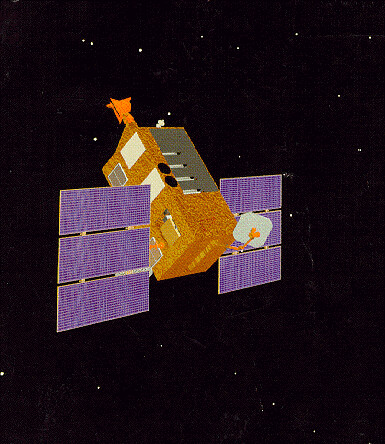Happy 15th Anniversary to RXTE!
- By Maggie Masetti
- December 30, 2010
- 1 Comment
Today is the 15th anniversary of the launch of the Rossi X-ray Timing Explorer (RXTE)! With its future in jeopardy, we thought we’d like to celebrate its long and useful life. Did you know that over its productive lifetime, there have been more than 2000 RXTE-related articles in scientific journals and more than 90 RXTE-related Ph.D. theses?
First, from the archives, we have this promotional video from 1991 that highlights the features and capabilities of the the RXTE, and is still largely applicable today. (Yes, that music certainly is “retro”!)
We also spoke with several project scientists for RXTE, Dr. Craig Markwardt, Dr. Tod Strohmayer, Dr. Hale Bradt (principle investigator of the All-Sky Monitor on RXTE), and Dr. Jean Swank (principle investigator for Proportional Counter Array (PCA) on RXTE).
Blueshift: How long was the RXTE mission originally supposed to last? Has the satellite operated beyond original plans?
Jean Swank: RXTE had a requirement of two years, with a goal of five years. Having the goal meant that the design should not preclude it lasting for five years. Predictions are made for the worst cases of atmospheric drag and the sun has been less active than that case. The two year requirement was the basis of the amount of testing electronic parts were subjected to.
Blueshift: What were your biggest hopes when RXTE launched? Have they come true?
Craig Markwardt: I first came to work for NASA in 1997, about one and a half years after RXTE launched. I was fresh out of graduate school, starting a postdoctoral appointment, and wanted to learn something new. When I started, I wasn’t thinking very far into the future because the new observations of the moment were so exciting. At that time, RXTE was a freshly launched mission, and the people I came to work with had no idea it would last 15 years or be so productive. My first project studied a black hole system in our own galaxy known as GRS 1915+105. This system sends out powerful jet ejections every few hours, earning it the nickname the “Old Faithful Black Hole.” Since then, we’ve discovered many black hole systems, inside and outside our galaxy, with many kinds of behaviors.
Tod Strohmayer: I came to GSFC in the summer of 1994 to work on RXTE as a member of the PCA (Proportional Counter Array) instrument team. For my thesis work I had done some studies on the pulsation modes of neutron stars, so I was very excited to have the chance to explore that with the new capabilities that RXTE was going to provide. Another thing that I was very interested in were X-ray bursts from neutron stars, and using RXTE to explore their variability properties in a really new way. These bursts are basically enormous hydrogen-bomb-like explosions on the neutron star surface. One of the most exciting RXTE discoveries I was involved with was finding strong, high frequency pulsations during many of these X-ray bursts. We now know that these pulsations are revealing the spin rate of the bursting neutron star. Some of them have been spun-up to where they are spinning around 600 times each second! RXTE was the first observatory to see these signals. That is still the most exciting thing to me about doing research, the chance that you might see something that no one before you has ever seen.
Hale Bradt: All I can say is that it has been one incredible ride, starting with the first proposals in 1974. We never expected 15 years of flight data. NASA guaranteed two years of operations, but, hoping for more, we deliberately designed it so it would not be artificially terminated by cryogens or maneuvering gases or early reentry. We also divided our detector systems so that single failures would not be totally catastrophic. The fifteen years of NASA support was only possible due to the rich yield of science that influenced the biennial Senior Review Boards to recommend continued funding. RXTE’s greatest discovery was to reveal kilohertz variability to the world, both periodic and aperiodic. I would remind one that RXTE was designed to detect and study such variability because the dynamic time scale of matter motions in the vicinity of stellar mass neutron stars or black holes lies in the kilohertz region. Such variability had been the object of searches for decades, but only RXTE, being designed for this purpose, had sufficient sensitivity and maneuverability to ferret it out. Of course, even then, it required the ingenuity and energy of creative observers to find it and to explore it with follow on observations.
Blueshift: In your opinion, what’s the most exciting thing that RXTE has discovered?
Tod Strohmayer: This is a hard question because one of the most amazing things about RXTE is the breadth of discoveries that have been made with it, so it’s hard to pick just one. One rather unexpected discovery was of fast oscillations that were found during two violent outbursts from ultra-magnetized neutron stars. These “magnetars” are the strongest magnets known in the universe. Three of them have produced these “giant flare” outbursts that are so intense that they can effect the propagation of radio waves through the Earth’s ionosphere. RXTE found high frequency oscillations from two of these giant flares, and current thinking suggests that these oscillations may be associated with the global vibration modes of the neutron star crust. It is thought that the giant flares may act like a giant “clapper” that sets the neutron star “ringing” like a bell. So RXTE is likely the first observatory to be exploring the seismology of neutron stars. Terrestrial seismologists use earthquakes to study the interior of the Earth, and the same ideas may be applicable to these magnetar oscillations. Neutron star interiors are not well understood, so these measurements may give us a new tool with which to peak in on the inner workings of neutron stars, which is very exciting.
Jean Swank: I still find the QPOs (quasi-periodic oscillations) the most exciting. [Note: Black holes and neutron stars can emit streams of X-rays that pulse over 1,000 times a second. The pulses are almost, but not quite, periodic, but vary slightly from cycle to cycle. Thus quasi-periodic.] It is exciting because the arguments are still hot about the causes. Each new system casts a special slant on the problem.
Craig Markwardt: I think the most exciting discovery occurred in early 1998, when the first known accreting millisecond X-ray pulsar was discovered in the system known as SAX J1808.4-3658. This system had been known to have occasional flare-ups, but 1998 was the first time that RXTE could point at it. What we found was rapid pulsations, which indicated a massive neutron star spinning once every 2.5 milliseconds (or 400 times per second).
Even better, the pulsations showed the tell-tale signature of orbital motion – via Doppler shifts – which told us that it was in a tight 2-hour orbit. This type of system had been theorized for several decades to occur, but RXTE was the first to demonstrate it with real observations. Based on this discovery by chance, the RXTE team set out to perform a dedicated monitoring program to detect more of this kind of system, for example near the galactic center, and we have been wildly successful. Today, more than thirteen such systems are known, and they tell us much about binary star systems are formed and change over time.
Blueshift: In your opinion, what’s the most surprising thing that RXTE has discovered?
Jean Swank: Perhaps the most surprising thing that RXTE has discovered is the magnetar-like outbursts from isolated young radio pulsars that have fields at the strong end for radio pulsars, but lower than the magnetars previously known. Can these sources which are are plentiful also produce the magnetar giant bursts which can ionize the earth’s atmosphere?
Craig Markwardt: I was very surprised by the discovery this past year of an eclipsing millisecond pulsar system, known as Swift J1749.4-2807. An eclipse occurs when the orbiting companion star gets in the way and temporarily blocks some of the X-ray light from the pulsar. This tells us even more about the system. In fact, this system gives us the first opportunity to directly “weigh” a neutron star, a measurement that has long been sought, because it allows us to understand material at extremely high densities.
Blueshift: What’s next for RXTE? Or will there be a next for RXTE?
Jean Swank: The fact that the result Craig thinks most surprising, the eclipsing millisecond pulsar, is a result from this year, shows the usefulness of the continued operations of RXTE. Studying such a system has only scratched the surface. These systems are sufficiently rare that it has taken a 15 year mission to find superbursts, an eclipsing neutron star, and a link between ordinary radio pulsars and magnetars. There could be an eclipsing black hole too in our galaxy.
Tod Strohmayer: RXTE has been and remains remarkably productive. This is due to the incredible team of dedicated people who have worked on it, including all the teams at RXTE’s partner institutes; MIT, UCSD, and NASA/GSFC. It still has some capabilities that, despite its age, remain unique to it. So while budgetary pressures have continued to squeeze RXTE’s operating budget, NASA has concluded that it is still valuable to operate the mission as long as resources are available to do so. At present, funding is available to continue operations through March 2011, and a continuation beyond that will be decided early in the new year. Because RXTE has found the fast X-ray timing domain so rich with discoveries, there are several efforts within the international astrophysical community to foster development of a follow-on mission to further explore the science frontiers opened up by RXTE.
Links:






hope can know much information About it!|Thank you for Posting & I got to read nice information on your site.|Thank you for useful info. :-) |Thanks for this